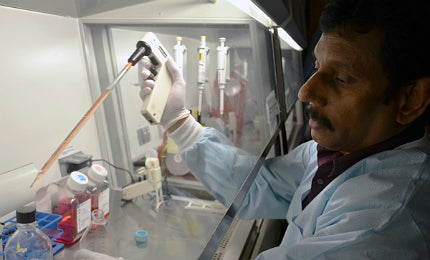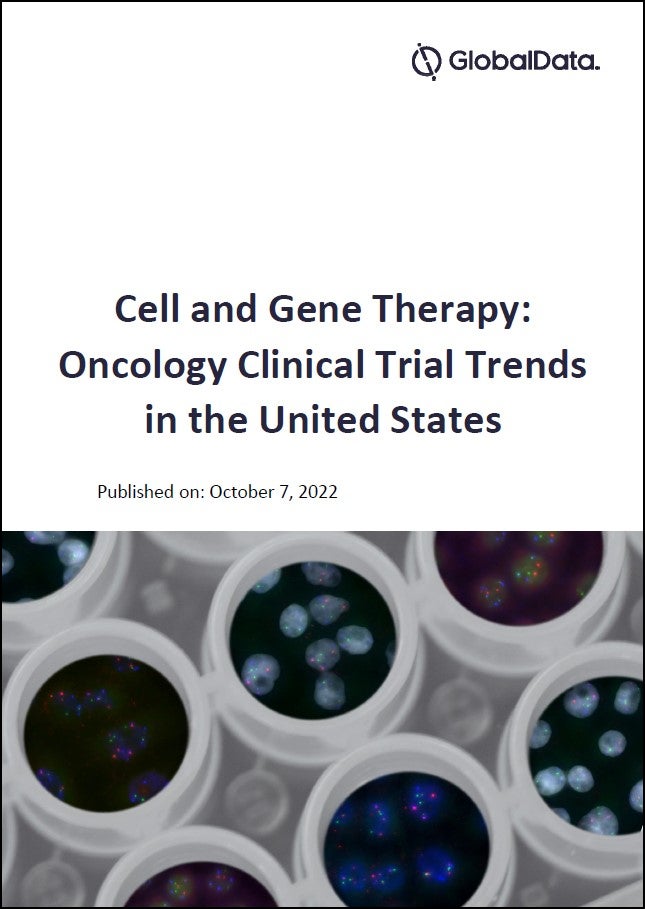

The recent outbreak of a new strain of bird flu in China has resurrected the ever-present spectre of global pandemic, the consequences of which are made all the more frightening by today’s increasingly mobile and densely packed populations.
How well do you really know your competitors?
Access the most comprehensive Company Profiles on the market, powered by GlobalData. Save hours of research. Gain competitive edge.

Thank you!
Your download email will arrive shortly
Not ready to buy yet? Download a free sample
We are confident about the unique quality of our Company Profiles. However, we want you to make the most beneficial decision for your business, so we offer a free sample that you can download by submitting the below form
By GlobalDataZoonotic diseases, those transmitted from animals to humans, are often the root cause of these outbreaks, from H1N1 swine flu to the new strain of the H7N9 avian flu virus that has so far claimed 17 lives in China. As a result, there’s an understandable paranoia surrounding these animal-transmitted diseases, to the extent that even laboratories replicating potential human pandemic strains for study have often been the cause of intense controversy.
But there is another side to infectious disease in animals and its study – a side that can bring life-saving benefits to humans. In the most obvious sense, experimentation with potentially dangerous virus strains is the best way to find out if they can be transmitted to humans, and how.
That’s not all that can be achieved with animal viruses. With the advent of complex lab technologies such as reverse genetics, virologists now have the means to modify and manipulate naturally occurring virus strains, re-shaping them to serve as innovative treatments for humans.
Newcastle disease virus vs. cancer
The most recent case in point is a study undertaken at the Virginia-Maryland Regional College of Veterinary Medicine in Virginia, US, the results of which were published in the April 2013 issue of the Journal of Virology.
The study investigated Newcastle disease, a contagious avian disease that can ravage poultry farms, with its most virulent strains spreading rapidly and causing up to 90% mortality. In the last month alone, outbreaks of the disease at poultry farms in Israel led to the culling of more than 10,000 breeding chickens and 33,000 turkeys.
While exposure to the disease can affect humans in some cases, it is mostly harmless, with symptoms limited to mild conjunctivitis and flu. In fact, it’s been established for decades that Newcastle disease virus (NDV) has potential as an anti-cancer agent, with human clinical trials previously carried out in the US and Israel.
The Virginia study’s aim was to enhance the potency and selectivity of NDV as a prostate cancer therapeutic, and address the main issue that has so far blocked this treatment method from progressing further. Dr. Elankumaran Subbiah, associate professor of virology in the Department of Biomedical Sciences and Pathobiology and one of the study’s authors, explains.
"When you look at all Phase I and II clinical trials, people have to give large quantities of virus – they have given one to ten billion viral particles to patients to get tumour regression. That is pretty inefficient, and requiring multiple injections," says Subbiah, who has 25 years’ experience of studying Newcastle disease. "That is not good, because when you inject once, the immune system picks up and then it starts producing antibodies, even through the Newcastle disease virus does not cause any disease in humans. But for any protein, the immune system will react by producing antibodies. So when they give a second injection, the human antibodies will neutralise the NDV."
Protecting NDV from the human body
So the researchers’ first task was to solve the problem of the NDV being attacked by the body’s complement system before arriving at the target site. Using the standard method of growing NDV in chicken embryos, Subbiah and his colleagues realised that the human serum’s response when introduced to the virus was simply too strong.
"We grew the virus in chicken embryos and tried to combine it with normal human serum from different people," Subbiah explains. "What we saw was the virus was completely neutralised by the serum, even though it did not have any anti-NDV-specific antibodies. It was normal serum, never exposed to Newcastle disease virus, from people who have never been exposed to Newcastle, but they neutralised the virus from chicken embryos."
The team discovered that, by growing the virus in human cells rather than chicken embryos, it was able to protect itself from the human immune response. This proved the key to developing NDV strains that are suited to surviving in the human body.
"We found out that the neutralisation was due to the complement system in the human body," Subbiah says. "When we grew the virus in human cells, it incorporated some complement regulatory proteins from the cell; the virus actually takes a piece of the cell to protect itself against the onslaught of the complement system."
Customising NDV to fight prostate cancer
Although manipulating NDV so it can resist the body’s immune response was a difficult and important task, without a potent and tumour-specific therapeutic effect, the project was only half-complete.
Subbiah wanted to make the virus more specific to the target cancer cell types, and funding from the US Department of Defense’s prostate cancer medical research programme prompted the team’s first target. Although prostate cancer is the subject of the researchers’ first study, Subbiah notes that NDV has a wide-ranging anti-cancer effect.
"Prostate cancer is the first model, and we are working on breast cancer, brain cancer, pancreatic cancer and lymphomas. So we have a range of cancer cell types and we know that NDV can actually kill different types of cancer cells, or any types of cancer cells for that matter."
Subbiah’s research group was able to make the virus specific to fighting prostate cancer by manipulating the Newcastle disease virus so that it is cleavable only by prostate-specific antigens (PSAs). "When we recovered the virus we tested it, and it was cleaved only by prostate-specific antigens, which are only available in prostate tumours, prostate cancers," Subbiah says. "Because in the blood, PSAs are not active, so only the prostate cancer cells have active PSA."
Using this method, Subbiah’s NDV anti-cancer treatment could represent a major improvement over the current standard of care involving chemotherapy and hormone treatment. In the case of prostate cancer, hormone treatment involves depriving the prostate cancer cells of androgen, eventually leading to the development of hormone-resistant prostate cancer, which limits the effectiveness of the treatment and is characterised by the increased production of prostate-specific antigens.
But for the NDV treatment method, more PSAs mean more antigens that can cleave the virus and deliver its effects. "In those instances, this virus will definitely take the upper hand, because you have more PSA," says Subbiah. "So it will work before you start hormone treatment, and after you start hormone treatment and people are advancing into late-stage disease, the virus will still kill the cancer cells. Not only that, being a virus that exclusively requires prostate-specific antigens for replication, it will seek out all those cells that produce it. That means metastatic cells in different areas. So even in advance-stage metastasis, it will work.
"And by making it very specific to PSA-producing cells, we made the requirement of the virus to be given in multiple doses and in large quantities unnecessary – we believe we can achieve the same results with very low quantities. That makes it much more tolerable. And we already know from the Phase I and II clinical trials with the naturally occurring strains, even with one to ten billion viral particles, patients never experienced any severe untoward side effects. So we don’t expect any safety issues."
Bringing NDV treatments to the clinic
Although Subbiah considers the oncological value of the NDV treatment to be beyond doubt, there is still a long way to go before it is ready for hospitals and clinics. "Right now we are in the discovery phase," says Subbiah. "[The treatment] has to be developed, and we need to do a lot of human clinical trials. Universities generally do not undertake that kind of enterprise because it costs anywhere between $100m to $500m to take it from discovery to the patient."
Subbiah is now looking for commercial partners from the pharmaceutical industry to help take the treatment into full-scale clinical trials. He notes that he has had discussions with one pharma company already, and other organisations have expressed interest, as well as wealthy individuals who have been affected by prostate cancer.
With enough support from donors and industry partners, Subbiah believes his method could be helping patients within the next five to ten years. "And because there is an extensive safety record for naturally occurring strains, we can actually combine Phase I and II trials together to speed things up," he adds.
Despite the fears surrounding the study of viruses – the kind of fears that saw intense opposition to avian flu research in the Netherlands and US that, in light of the latest outbreak, could prove invaluable – Subbiah firmly believes in the benefits of harnessing animal viruses to improve human health.
"Veterinarians and animal virologists can provide a lot for maintaining human health," he says. "And as we can see, the majority of zoonotic diseases come from animals, and most of the emerging diseases – about 60-70%, depending on what figures you are looking at – are transferred from animals to humans. From H7N9 to H1N1 to Ebola, all of them have animal origins. These viruses can cause havoc in human populations, but you can also use them to benefit humans."
After all, the study of the therapeutic effects of viruses, both human and animal, has a long history – a history that is leveraged to unlock exciting clinical possibilities, while maintaining high standards of safety.
"We took a non-human virus because it is flexible; we can genetically manipulate it, then we can target it and add additional therapeutic payloads into the virus," says Subbiah. "Then we can track where the virus goes, because we have viruses that glow green. We can even specifically target the virus to a receptor on a particular cell type. We take a non-human virus, an avian virus, and modify it in such a way that it doesn’t cause even mild illness. The use of animal viruses and animal infectious agents for improving human health is a method we should be looking at."
Related content
The outdoor lab: growing pharmaceuticals in plants
Growing medicines in open fields could slash the cost of drug production and make life-saving vaccines easily available to people in the developing world.
Trialling the first ever HIV vaccine
The HIV virus has posed great challenges for scientists, primarily because of the way the virus compromises the body’s immune system.




